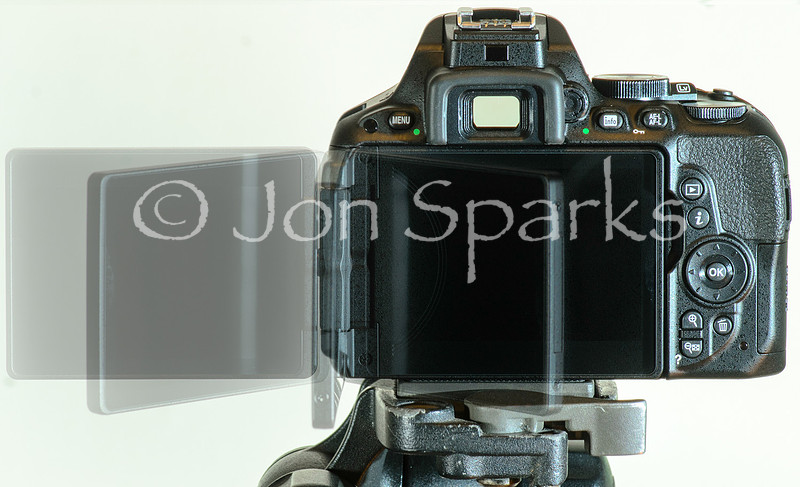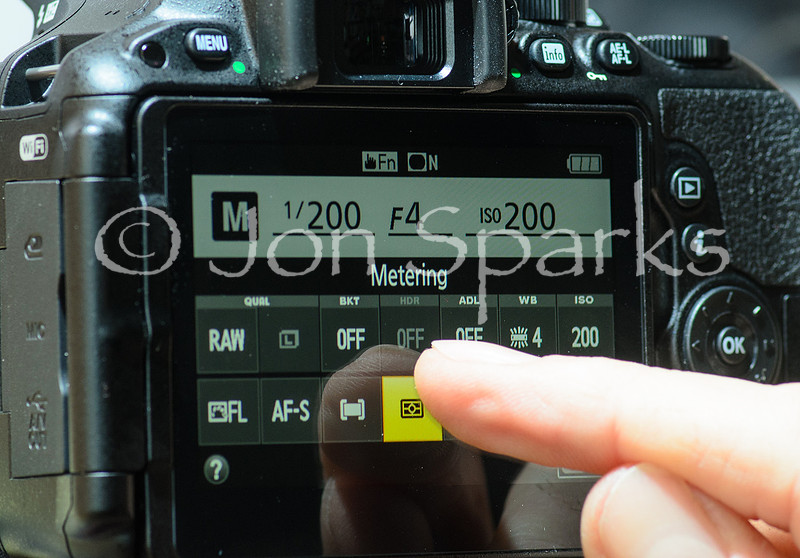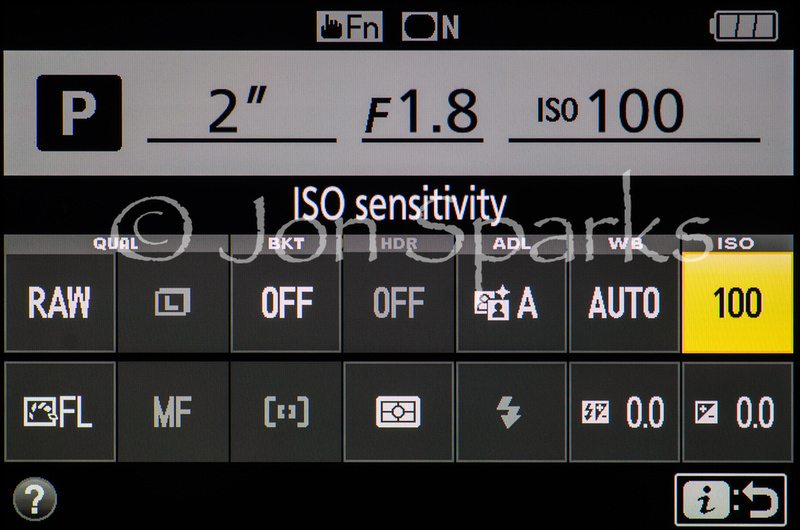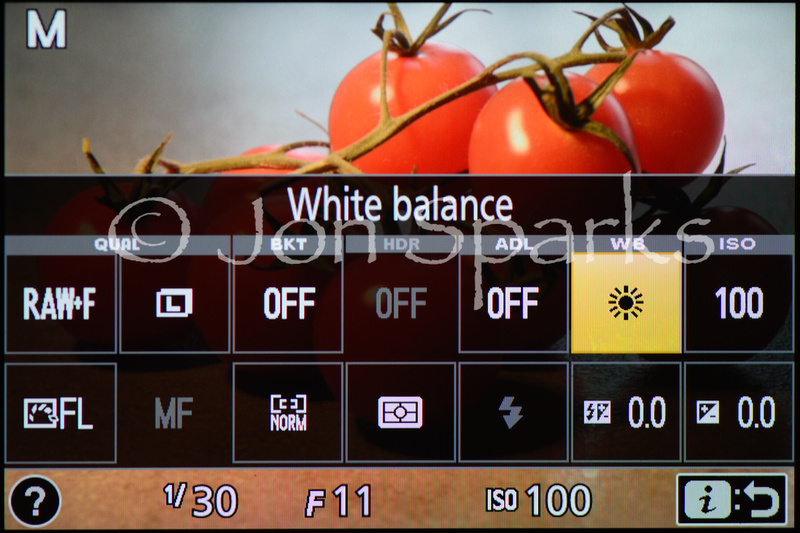I’ve just completed the text for the Expanded Guide to the Nikon D5500. This is definitely a first draft; there is still a lot of careful checking to be done. But it's all in the right place and it's turned out at the right length too!
It's a nice camera in many ways and capable of excellent results, but in most respects not radically different from its predecessors. The headline feature on this camera is undoubtedly the introduction of a touch-screen.
This is the first time I've used a DSLR with a touch-screen but I’ve been working intensively with this one for a few weeks and I thought I’d share my initial thoughts about it.
I’ve always been somewhat sceptical about the benefits of touch-screens, at least on cameras which are fundamentally designed to be used at eye-level. Has the D5500 changed my views? Read on...
 A flexible screenA flexible screen
A flexible screenA flexible screen It’s worth saying at the outset that when I’m working on an Expanded Guide I do all sorts of things with a camera that I generally wouldn’t do in my regular shooting. This is obviously necessary in order to be properly familiar with all the modes and functions. And it isn’t a bad thing for me personally as it does mean that I don’t get totally set in my ways. I do regularly get a fresh perspective on my habitual ways of working and this does occasionally lead to changing the way I do things.
It’s worth saying at the outset that when I’m working on an Expanded Guide I do all sorts of things with a camera that I generally wouldn’t do in my regular shooting. This is obviously necessary in order to be properly familiar with all the modes and functions. And it isn’t a bad thing for me personally as it does mean that I don’t get totally set in my ways. I do regularly get a fresh perspective on my habitual ways of working and this does occasionally lead to changing the way I do things.
A quick example: I was pretty sceptical about Live View when it first appeared. A DSLR is an eye-level camera, isn’t it? Well, it is, and the viewfinder will always be my first choice for most shooting, but Live View does have an advantage when focusing is super-critical, e.g. shooting with very long lenses or in macro. It’s very accurate and you can zoom in on any part of the image to check focusing even more precisely. My default setting for macro shooting is now tripod + Live View zoom + manual focus. I’d probably have figured that out sooner or later but because working on the Guides obliged me to explore Live View, it happened sooner.
But back to the touch-screen. Let’s look at how it works in four main areas: normal shooting (i.e. using the viewfinder); Live View (and movies); menu navigation; and playback.
 _D7K3157
_D7K3157 Normal shooting
Normal shooting
Again, working on a Guide is not like my regular everyday photography. It involves a lot of playing around with different modes and different settings. And for a lot of this, using the touchscreen probably is significantly quicker than using more traditional methods. For many operations on the D5500 you have to highlight a setting using the multi-selector (most other cameras have an equivalent control), then press OK to activate it. With the touchscreen a simple tap turns two steps into one. Not only is this quicker, this soon feels intuitive too.
However, some of these comparisons would pan out differently on other cameras which have a few more dedicated buttons. In fact, all the SLRs ‘above’ the D5500 in the Nikon range also have a separate control panel on the top-plate and it’s easy to change key settings like image quality, white balance and so on using this: just hold the appropriate button and turn the main command dial (or sometimes the sub-command dial for further options). This is quicker than activating the touchscreen and then making a change in settings – but only once you’re familiar with the location of the buttons. I can see that many photographers new to DSLRs – especially if they’re familiar with other touch devices like a smartphone or tablet – will now never learn where the buttons are, and so will miss out on what can be the quickest way to change many settings.
I also am fairly sure, though I don’t have hard evidence, that using the control panel is less draining on the battery than using the touchscreen. This is probably of no practical significance unless you (a) change settings an awful lot and (b) are on a long trip without a spare battery or chance to recharge. But still...
There’s one area where the touchscreen is clearly much slower – and it’s a pretty basic one. This is in setting aperture or shutter speed. First you have to activate the display then tap on-screen arrows – and each tap only changes the setting by 1/3 Ev. It’s far quicker to use the command dial. On the D5500, which only has one command dial, you have to hold the exposure compensation button and turn the dial to set aperture in manual mode, but it’s still loads quicker.
What's more, you can change shutter speed and aperture without taking the camera from your eye as they are shown in the viewfinder. This is particularly important if you’re shooting sports or other action. And the same applies to ISO setting, too, which of course is the third point of the ‘exposure triangle’ and really, on a digital camera, should come into play just as much as the other two. On the D5500, you hold the Fn button (assuming you haven’t changed its default function) and turn the dial to do this. You do need to change a Custom setting (b2, since you asked) to get ISO shown in the finder, but this is a one-time action and honestly it’s a no-brainer. Do it.
In my everyday shooting, I’ll probably never touch most of the settings (Image quality, Picture Control, White Balance, etc) from one end of the day to the other. The things that I do adjust all the time are shutter speed, aperture, and ISO. The touch-screen is a hindrance for these, so I’ll make little or no use of it in normal shooting.
 Tap to adjust any of these optionsTap to adjust any of these options
Tap to adjust any of these optionsTap to adjust any of these options Live View
Live View
In Live View, of course, things are a bit different. The screen is already active and you’re using it to frame shots anyway, so there’s much less time lost in transferring your attention to the touch-screen. For most settings, especially the ones you can access quickly by pressing the i button (see footnote), it’s probably quicker to use the touch-screen. It’s still way quicker to use the dial for shutter-speed and aperture, however, and it’s probably a score-draw when it comes to ISO.
But the touch-screen does bring something new to Live View; the ability to tap a point on screen to make the camera focus there. This is much, much quicker than laboriously moving the focus point with the multi-selector and then pressing another button to make the camera focus on it. A big win for the touch-screen here, I’d say.
However, I should add that this only speeds up your half of the focusing process – the bit where you tell the camera where to focus. Actual focusing (the camera’s part of the process) in Live View is still a bit slow and certainly not much good for shooting action. (Surprising that Nikon’s DSLRs aren’t better at this, when the focusing in the Nikon 1 mirrorless cameras is so good).
Personally, when I’m using Live View, I’m also using manual focus much of the time. And what would speed this up is if I could zoom in on the key area with a gesture, or even press the zoom button and then drag a finger to see a different area in the magnified view. Without this, zooming to view a particular area means you have to position the focus point over it first and then use the zoom button. It’s a let-down, and doubly so because you can gesture-zoom in playback (see below).
There’s one other aspect that I haven’t mentioned, which is the ‘touch-shutter’. You have to enable this by tapping an icon on the screen. Once you’ve done this, if you tap a point on the screen the camera will focus there – and when you lift your finger it will take a shot.
I’m really not convinced there’s any advantage to this. Yes, if you’re interacting with the camera solely through the screen, it may seem logical to have this option. But every time you focus on A and then decide you don’t want to take that shot and want to focus on B instead, the camera will take a picture anyway. Of course you can delete the unwanted shot(s) afterwards but still, a function that takes pictures you don’t want is not a very smart function. Needless to say, I quickly disabled the touch shutter and don’t envisage ever using it again.
 _D6C1331
_D6C1331 Menu navigation
Menu navigation
On the face of it, the touch-screen speeds up menu navigation enormously. Instead of scrolling to an item to highlight it, and then pressing OK to accept or move to the next step, you can just tap the item. It cuts the time taken by at least 50% and often much more.
However, the downside for me is that every now and then I tap on the wrong item. You do need to be quite precise as the target areas are quite small (just over 4mm deep). Or maybe it’s just my clumsy fat fingers. And when you do tap in the wrong place it often means having to undo the setting you didn’t mean to change before going back and redoing the one you did.
Still, on balance, it’s a notable improvement. And in one area – text entry – it’s absolutely streets ahead of the older way. I might even use features like Image comment more often now that entering text has become easy, instead of painfully tedious.
 _D7K3142
_D7K3142 Playback
Playback
On the whole I think playback is where the touch-screen really shines. It is natural and easy to swipe left or right to scroll through pictures, and to stretch or pinch to zoom in or out. The improvement is even more noticeable when you hand the camera to someone else who wants to look through your pictures; they’re far more likely to be used to this way of doing things than using the multi-selector.
There’s one blemish, though. You can scroll left or right by touch but you can’t scroll up/down through the different info screens for each image (highlights, histogram, metadata and so on). I use these a lot, especially the histogram, which any serious photographer should refer to regularly. You still have to use the multi-selector for this, and it feels more awkward to do so when you’re switching to it from intuitive gesture-navigation. If Nikon can fix this for future iterations it will be a real benefit.
In general
Of course some of these comments are determined by the specific way Nikon has implemented the touch-screen on the D5500 and some of the shortcomings I’ve mentioned could easily be addressed. Even so, there are clearly some areas where using the touch-screen is easier and faster than other methods and as long as I’m using the D5500 (though it’ll be going back in a few weeks), I’ll happily make use of them, probably more so in Live View than in normal shooting. Nikon’s implementation for Live View does leave a little to be desired, but it undoubtedly speeds up certain operations.
At the same time, I do still have a few reservations. The first is one I’ve already mentioned – that photographers new to DSLRs may get suckered into using the touch-screen for everything, even those areas where it clearly isn’t superior. An SLR is still first and foremost an eye-level camera. You should be able easily to adjust crucial settings without taking the camera away from your eye – and you can.
I also wonder about the durability of the touch-screen, which of course now gets much more hammer than non-touch-enabled screens. After the first day or two playing with the camera, the screen was already seriously in need of cleaning. Nikon doesn’t provide any sort of screen protector but if I were going to keep this camera I’d certainly be looking for one. And as an outdoor photographer, sometimes shooting under time pressure in challenging conditions, I’m a bit concerned about the ruggedness of fold-out screens more generally, too.
As an outdoor photographer I’m also very conscious of how cameras handle when you’re wearing gloves, and clearly touch-screens and gloves don’t play nicely together. (I’m aware there are gloves which claim to work with touch screens but you still lose some of the precision which is definitely needed to use this one). Clearly I’m not going to be pulling off my right glove every time I want to adjust something, so it is important that control through buttons and dials remains available and straightforward. Any camera that only lets you do things through a touch screen is a non-starter for me (one reason why I don’t see the iPhone as a serious full-time camera).
Bottom line
I guess I half-expected to find that a touch-screen on a DSLR was a pointless gimmick. It’s not. It’s genuinely useful and beneficial for some things. But it’s not a panacea and some operations are still best done by other means.
In future if I have a camera with a touch-screen in my hands I’ll use it for the tasks it’s good at. But the presence or absence of a touch-screen is going to be fairly low on my list of priorities next time I go looking to buy a camera for myself. I like it more than I expected to but I can still live without it.
Footnote: Settings you can access quickly in Live View by pressing the i button:
Image quality, Image size, Bracketing, HDR, Active D-Lighting, White balance, ISO, Set Picture Control, AF mode, AF-area mode, Metering pattern, Flash mode, Flash compensation, Exposure compensation
Out of these, ISO, Flash compensation, and Exposure compensation are more easily accessed by button and dial.
I think Metering pattern is a waste of space here. I never shift out of matrix in normal shooting: for critical exposure assessment I rely on a test shot and looking at the histogram. I’d like to bet that upwards of 95% of owners of a camera like this will use matrix all the time too, or depart from it once in a blue moon. I’d far rather see Release mode on this list. There is a dedicated Release mode button on the D5500, but it’s in a rotten place – a rare fail for Nikon, who usually do a damn good job with their camera ergonomics.